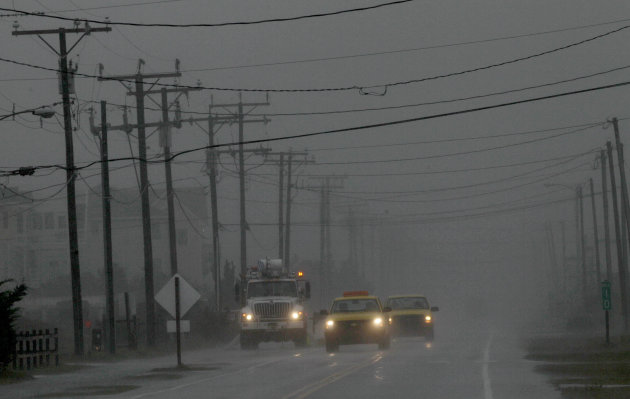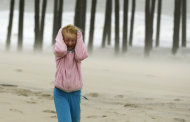Eastern US braces for dangerous superstorm
By | Associated Press – 2 hrs 11 mins ago
NEW YORK (AP) — From Washington
to Boston, big cities and small towns were buttoned up Monday against
the onslaught of a superstorm that threatened 50 million people in the
most heavily populated corridor in the nation, with forecasters warning
that the New York area could get the worst of it — an 11-foot wall of
water.
"The time for preparing and talking is about over," Federal Emergency Management Administrator Craig Fugate said Sunday as Hurricane Sandy
made its way up the Atlantic on a collision course with two other
weather systems that could turn it into one of the most fearsome storms
on record in the U.S. "People need to be acting now."
Forecasters
said the hurricane could blow ashore Monday night or early Tuesday
along the New Jersey coast, then cut across into Pennsylvania and travel
up through New York State on Wednesday.
Airlines canceled more than 7,200 flights and Amtrak began suspending train service across the Northeast. New York,
Philadelphia, Washington and Baltimore moved to shut down their
subways, buses and trains and said schools would be closed on Monday.
Boston also called off school. And all non-essential government offices
closed in the nation's capital.
The New York Stock Exchange
said it will be shut down Monday, including electronic trading. Nasdaq
is shutting the Nasdaq Stock Market and other U.S. exchanges and markets
it owns, although its exchanges outside the U.S. will operate as
scheduled.
As rain from the
leading edges of the monster hurricane began to fall over the Northeast,
hundreds of thousands of people from Maryland to Connecticut were
ordered to evacuate low-lying coastal areas, including 375,000 in lower
Manhattan and other parts of New York City, 50,000 in Delaware and 30,000 in Atlantic City, N.J., where the city's 12 casinos were forced to shut down for only the fourth time ever.
"We
were told to get the heck out. I was going to stay, but it's better to
be safe than sorry," said Hugh Phillips, who was one of the first in
line when a Red Cross shelter in Lewes, Del., opened at noon.
"I
think this one's going to do us in," said Mark Palazzolo, who boarded
up his bait-and-tackle shop in Point Pleasant Beach, N.J., with the same
wood he used in past storms, crossing out the names of Hurricanes Isaac
and Irene and spray-painting "Sandy" next to them. "I got a call from a
friend of mine from Florida last night who said, 'Mark, get out! If
it's not the storm, it'll be the aftermath. People are going to be
fighting in the streets over gasoline and food.'"
Authorities
warned that the nation's biggest city could get hit with a surge of
seawater that could swamp parts of lower Manhattan, flood subway tunnels
and cripple the network of electrical and communications lines that are
vital to the nation's financial center.
Sandy,
a Category 1 hurricane with sustained winds of 75 mph as of Sunday
evening, was blamed for 65 deaths in the Caribbean before it began
traveling northward, parallel to the Eastern Seaboard. As of 2 a.m.
Monday, it was centered about 425 miles southeast of New York City,
moving to the north at 14 mph, with hurricane-force winds extending an
incredible 175 miles from its center.
Gale force winds reported over coastal North Carolina, southeastern Virginia, the Delmarva Peninsula and coastal New Jersey.
Sandy
was expected to hook inland during the day Monday, colliding with a
wintry storm moving in from the west and cold air streaming down from
the Arctic.
Forecasters said
the combination could bring close to a foot of rain in places, a
potentially lethal storm surge of 4 to 11 feet across much of the
region, and punishing winds that could cause widespread power outages
that last for days. The storm could also dump up to 2 feet of snow in
Kentucky, North Carolina and West Virginia.
Louis
Uccellini, environmental prediction chief for the National Oceanic and
Atmospheric Administration, told The Associated Press that given Sandy's
east-to-west track into New Jersey, the worst of the storm surge could
be just to the north, in New York City, on Long Island and in northern New Jersey.
Forecasters
said that because of giant waves and high tides made worse by a full
moon, the metropolitan area of about 20 million people could get hit
with an 11-foot wall of water."This is the worst-case scenario," Uccellini said.
New York Mayor Michael Bloomberg warned: "If you don't evacuate, you are not only endangering your life, you are also endangering the lives of the first responders who are going in to rescue you. This is a serious and dangerous storm."
New Jersey's famously blunt Gov. Chris Christie was less polite: "Don't be stupid. Get out."
New York called off school Monday for the city's 1.1 million students and shut down all train, bus and subway service Sunday night. More than 5 million riders a day depend on the transit system.
Officials
also postponed Monday's reopening of the Statue of Liberty, which had
been closed for a year for $30 million in renovations. The United
Nations said it would close Monday and canceled all meetings at its
headquarters.
In Washington, President Barack Obama promised the government would "respond big and respond fast" after the storm hits."My message to the governors as well as to the mayors is anything they need, we will be there, and we will cut through red tape. We are not going to get bogged down with a lot of rules," he said.
He
also pleaded for neighborliness: "In times like this, one of the things
that Americans do is we pull together and we help out one another And
so, there may be elderly populations in your area. Check on your
neighbor, check on your friend. Make sure that they are prepared. If we
do, then we're going to get through this storm just fine."
The
storm forced the president and Mitt Romney to rearrange their campaign
schedules in the crucial closing days of the presidential race. And
early voting on Monday in Maryland and the District of Columbia was
canceled.Despite the dire warnings, some people were refusing to budge.
Jonas Clark of Manchester Township, N.J. — right in the area where Sandy was projected to come ashore — stood outside a convenience store, calmly sipping a coffee and wondering why people were working themselves "into a tizzy."
"I've seen a lot of
major storms in my time, and there's nothing you can do but take
reasonable precautions and ride out things the best you can," said
Clark, 73. "Nature's going to what it's going to do. It's great that
there's so much information out there about what you can do to protect
yourself and your home, but it all boils down basically to 'use your
common sense.'"
In New Jersey,
Denise Faulkner and her boyfriend showed up at the Atlantic City
Convention Center with her 7-month-old daughter and two sons, ages 3 and
12, thinking there was a shelter there. She was dismayed to learn that
it was just a gathering point for buses to somewhere else. Last year,
they were out of their home for two days because of Hurricane Irene.
"I'm
real overwhelmed," she said as baby Zahiriah, wrapped in a pink blanket
with embroidered elephants, slept in a car seat. "We're at it again.
Last year we had to do it. This year we have to do it. And you have to
be around all sorts of people — strangers. It's a bit much."
Before leaving their home in Atlantic City,
John and Robshima Williams of packed their kids' Halloween costumes so
they could go bunk-to-bunk trick-or-treating at a shelter. Her
8-year-old twins are going as the Grim Reaper and a zombie, while her
6-year-old plans to dress as a witch.
"We're just trying to make a bad situation good," the mother said. "We're going to make it fun no matter where we are."
___
Breed
reported from Raleigh, N.C.; Contributing to this report were AP
Science Writer Seth Borenstein in Washington; Katie Zezima in Atlantic
City, N.J.; Wayne Parry in Point Pleasant Beach, N.J.; and Dave Dishneau
in Wilmington, Del.



No comments:
Post a Comment